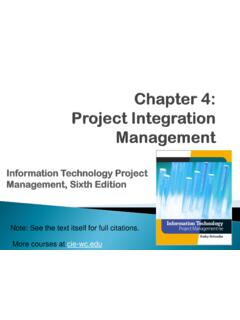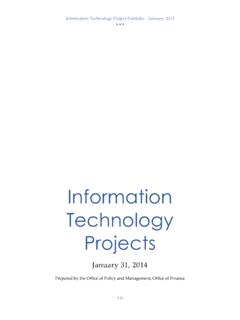Transcription of ITS Project Management Methodology
1 ITS Project Management Methodology information technology Services Project Management Group 11/17/2014 Version Author: ITS Project Management Group Document Control Change Record Date Author Version Change Reference 8/5/2009 Marion Bashista Major revisions and rearranged content added change Management , activities, and outputs and deliverables revised Requirements Matrix 10/2/09 Marion Bashista Updated per David Turner s review. 2/16/12 Marion Bashista Updated process per revised process flow approved by SMT Reviewers Sign Off Date Reviewer Position Sign Off Distribution Copy Number Name Table of Contents 1 BACKGROUND 2 DEFINITIONS Management Management Management 3 Project CLASSIFICATION Do We Classify? Do We Classify? the Project Size Matrix the Project Risk Matrix 4 Project Management Methodology and Deliverables and Deliverables and Deliverables and Deliverables and Deliverables 5 Project CLASSIFICATION- Methodology REQUIREMENTS MATRIX 6 Project INITIATION PROCESS FLOW 7 STANDARD ROLES AND RESPONSIBILITIES Sponsor (Class 4/5 Project ) Committee (Class 4/5 Project ) Committee Sponsor Manager Lead Member Designer Developer Analyst 8 GLOSSARY 1 Background This ITS Project Management Methodology document provides information technology Services (ITS) Project teams with a set of standards to initiate and manage individual projects.
2 The Methodology provides tools to make the Project manager s job a little easier. It contains definitions, guidelines, and templates for the various Project Management activities needed to deliver successful projects. The Methodology establishes common ground for all projects within UCSC ITS. The ITS Project Management Methodology development process was guided by the following objectives: The design should seek to be reasonable, comprehensive, flexible, and accessible. The content will enforce discipline but not disallow application of a Project manager s critical judgment and insight. The standards in this Methodology serve as assets to each ITS Project manager and team, and provide a common format for evaluating progress toward Project goals, objectives, and deliverables. The Methodology encourages a top-down approach to Project Management . It ties directly to the Project life cycle phases and provides a more precise definition of projects, a common lexicon used in Project Management , and a framework of activities mapped to each Project class size.
3 The ITS Project Management Group (PMG) built the Project Management Methodology , a customized Project Management Methodology , to enable ITS Project managers to focus on those processes that bring value. This Methodology : Provides a common language for communicating and planning prior to the start of the Project work. Encourages appropriate communication and planning prior to the start of Project work Establishes a means for managing projects more efficiently Enables the tracking of progress against pre-determined metrics and facilitates standardized reporting. Leads to effective Project outcomes which achieve institutional objectives Builds on a set of best practices learned over time. The long-term intent is to build a Project Management repository to document best practices, lessons learned, and examples of various documents that may be developed during a Project . The UCSC ITS Project Management Methodology is an adaptation of the Project Management Methodology described in Effective Project Management : Traditional, Adaptive, Extreme, 3rd Edition, by Robert Wysocki and Rudd McGary, and published by John Wiley & Sons in 2003.
4 2 Definitions Project Methodology makes assumptions about the use of specific terms and Project Management issues. This section defines some of the key terms and differentiates their use. Specific Project roles are defined in Section 4 Standard Roles and Responsibilities. Problem/opportunities are those campus IT endeavors vetted and communicated beyond the boundaries of the organization. They are those efforts that meet any of the following conditions: Have an impact beyond the division sponsoring the effort ( changes or creates a new process or a procedure or function) Create benefits beyond the sponsoring division Initiate a partnership with an external stakeholder ( Regulatory requirements) Influence or are influenced by strategic planning Require resources external to the unit/organization to successfully complete the problem/opportunities Through the process of program and Project structuring each campus problem/opportunities may develop into programs or a set of projects for implementation.
5 A Project is group of related work activities organized under the direction of a Project manager which, when carried out, will achieve specified objectives within a stated timeframe. A Project has a defined scope, deliverables or outcomes, work steps, duration, and budget as defined in a Project Charter. A Project Is temporary with a distinct beginning and end Is a minimum of 80 hours Is defined by specific deliverables Is conducted by a temporary team that exists for its execution Has a single Project manager who is responsible for its success Is defined by identifying the starting point, the goal/objectives, and the route between them Management Project Management defines managing single projects that meet the following general guidelines: The Project has a logical scope. Duration is typically from 3 months to 5 years. Team size is typically less than eight members including the Project manager. There is a single Project sponsor. There is a single Project manager.
6 A Program is a group of related projects that address a common business goal or problem/opportunities. Individual projects comprising a program are interdependent and must be successfully completed for the business program to meet its objectives. Programs provide a means of organizing and managing large, complex, or longer-term Project efforts. The overall effort is subdivided into a set of small interdependent projects, each of which implements some portion of the overall solution. Management Program Management is the means by which multiple projects are managed to achieve a common strategic business goal or objective. Program Management may be applied to any opportunity too large to address with a single Project . Management Portfolio Management is the process by which a set of campus problem/opportunities are identified, evaluated, ranked, matched to available funding, and approved for implementation. It requires consultation and close collaboration of the IT function, clients and key executive stakeholders, and sponsors.
7 Portfolio Management is a key governance process for the activities of the IT function. The goal of portfolio Management is maximization of the total value realized by the implementation of a set of proposed problem/opportunities given finite funding and resources. Portfolio Management must be tightly integrated with program and Project Management so that problem/opportunities can be properly scoped, estimated, and structured into programs and projects. 3 Project Classification The Methodology is not a one-size-fits-all Methodology . Rather it is an approach that specifies the processes used to manage a Project based on its characteristics. Those characteristics are defined so that classes of projects are formed and so that each class has its own specification as to which parts of the Methodology are appropriate. Do We Classify? The amount of documentation and required Project Management activities should scale to size of each Project . This approach is strongly advocated as it adapts the Methodology to the Project .
8 The value of the characteristics are used to determine which parts of the Project Management Methodology must be used and which parts are left to the discretion of the Project manager to use as he or she sees fit. In the final analysis, defer to the judgment of the Project manager. Apart from those required by the organization, the Project manager should adopt whatever parts of the Methodology he or she feels will improve their ability to help successfully manage the Project . Do We Classify? All projects can be classified into a Project class based on the amount of work effort and risk. A small Project would fall into Class 1 while a very large Project would fall into Class 5. The amount of documentation and required Project Management activities scales to size of each Project . Classification is a two-step process. First, using the Project Classification Sizing Matrix, the initial class of the Project is determined. The second step uses the Project Risk Matrix as a modifier of the Project s initial class to determine the actual class.
9 The Project Size Matrix Project class is initially determined based on work effort represented by the estimated duration (not number of person-hours) required to complete the work. Table - ITS Project Classification Sizing Matrix the Project Risk Matrix Although work effort is a good indicator for the amount of Project Management that should be expended, certain factors can also bring about the need for the application of more robust Project Management practices. The Risk Matrix identifies six risk factors to be evaluated once the initial classification level is determined. In the event that the total risk score is greater than 10, the classification level should be increased. Table - ITS Project Classification Risk Matrix 4 Project Management Methodology A Project Management Methodology is a: Conceptual framework for program and Project Management Set of guidelines, standards and processes It is an evolving vehicle for sharing and communicating lessons learned and best practices for program and Project Management .
10 The purpose of a Project Management Methodology is to: Provide Project managers and teams advice and guidelines to deliver better and consistent Project results Provide a common language and framework describing programs, projects and the practice of Project Management Provide Project managers a means of sharing and leveraging experience, lessons learned, and best practices. The Methodology described here is intended to be a starting point for the Project manager to think about structure and manage their projects. It is a work in progress. It is the PMG teams intention that this Methodology will be augmented and refined over time by the collective experience at UC Santa Cruz. The Methodology outlined here is a synthesis of current practices on the campus and specific methodologies employed by consulting firms and other organizations worldwide. To simplify the design and execution of campus projects, this Methodology is comprised of five Project Management phases.













